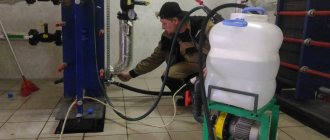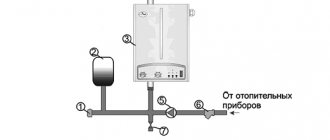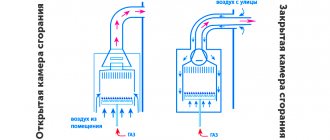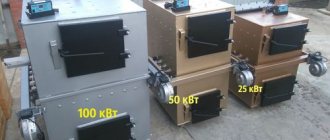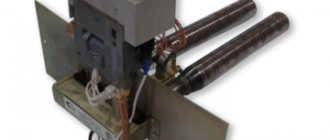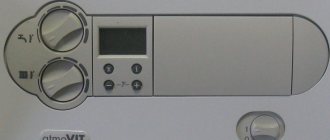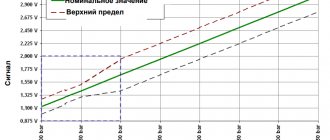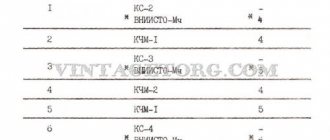When the question of which heating radiators is best to choose for a private home appears on the agenda, there are many who nostalgically recall Soviet cast-iron “accordions” - although bulky, they are hot and warm the room well. Indeed, at one time such batteries worked “excellently,” but now they are deteriorating and are considered obsolete. They have already been replaced by new, more efficient, convenient and cost-effective models.
But the main problem is that there are many diametrically opposed opinions regarding new radiators. And in practice it’s the same: you go to neighbors who have installed modern radiators at home - some are warm, while others are cold. At the same time, both places have almost identical heating batteries - that is, which of them is better for a private home does not always depend on the specific model.
Heating a house with radiators
Classes of heating radiators and their types and features
The principle of operation of a radiator is to transfer heat to the surrounding space from the coolant fluid circulating in this heating device.
The autonomous heating system (AHS) consists of:
- boiler;
- pipelines;
- thermal elements.
The table shows the main types of thermal appliances:
| Device | Operating principle | Example |
| Radiator | Heat is radiated | ceiling radiant panels, sectional cast iron, tubular radiators |
| Battery | Heat is radiated and also transferred by convection | sectional aluminum, sectional steel, bimetallic, tubular |
| Convector | Heat is mainly transferred by convection | plate, tubular convectors, finned tubes |
Heating a house with radiators
In addition, heating devices are divided into the following classes, let's consider a unique rating of heating radiators from this side:
Sectional
They consist of heating sections that are connected to each other. The more sections, the more heat they will transfer to the surrounding space. To prevent the room from overheating, special thermostats are installed on the radiators to regulate the temperature.
Standard cast iron radiators are also sectional: heat from them is transferred in the form of infrared radiation, evenly distributed throughout the room - top, bottom and middle. Such batteries have large dimensions and thick walls, which accumulate enough heat so that it is emitted in the infrared spectrum. It is this method of heating that is considered optimal for human health, although it must be borne in mind that part of the heating also occurs through convection.
Thanks to the thick walls, such batteries have high thermal inertia - therefore, after turning off the AOS, the radiators remain hot for a long time. Cast iron is not very susceptible to corrosion and is not afraid of harmful impurities in the coolant - the service life of such devices reaches 50 years. One of the disadvantages is the heavy weight.
Aluminum radiators have good heat transfer (1/2 radiation + 1/2 convection) and quickly warm up the room. Compared to cast iron, they are more lightweight, and in general, the ability to transfer heat into the room is several times higher than that of cast iron and steel.
An additional advantage of modern models is the ability to regulate the temperature using a valve with a thermal head. The metal surface is coated with a protective coating, which increases its service life. The cost of aluminum radiators is low, and therefore the prices are more affordable.
Aluminum radiators cannot withstand high overloads, so they are not used in central heating systems (CHS). They break due to pressure surges, the presence of rust or sand particles in the coolant. Chemical additives are not allowed in liquids.
Bimetallic heating radiators consist of external aluminum plates and steel pipes located inside the sections. They are valued for their reliability and durability, but are not cheap. Equally well suited for centralized and autonomous heating systems.
Radiators are also produced that have only steel-reinforced vertical pipes. These are no longer completely bimetallic devices; they are less corrosion resistant. Among their advantages, it is worth noting their high thermal conductivity, which is higher than that of real bimetallic radiators.
Tubular
Steel tubular heating devices give off heat well, are economical in terms of energy consumption, and heat up quickly. Their disadvantage is that they are sensitive to oxidative processes. If the coolant fluid does not fill the steel radiator reservoirs, it will begin to corrode. Another weakness of a steel radiator is its hypersensitivity to water quality. Even if the water is considered good by usual standards and can be drunk, it is recommended to install filters to minimize the formation of scale.
The sizes of steel tubular radiators are from 30 cm to 3 m. The number of rows of tubes is 1–9. They are considered very reliable - the permissible operating pressure for devices from a number of Russian manufacturers reaches 15 atm. Radiator reservoirs are designed to hold a large volume of liquid, so they quickly reach the required temperature levels when it is necessary to increase or decrease power. The method of heat transfer is radiation and convection.
Steel radiators are also used as heated towel rails, which, in addition to drying clothes, provide additional heating in bathrooms
Floor radiators-benches with support legs are steel tubular heating devices with a seat in the form of a wooden board on top. They are connected to the heating system in the same way as conventional radiators. They can also serve as the main heating device in rooms such as the kitchen, bathroom, hallway.
Panel
These steel radiators are a rectangular panel that acts as a heating device. The panel consists of 2 ribbed sheets welded to each other; plates with a U-shaped relief are placed inside.
Operating pressure is 6–8 atm, high sensitivity to pressure changes, therefore they are used only in autonomous heating systems for residential and commercial premises. Such radiators can consist of 1, 2, 3 heating plates. React quickly to temperature changes. The main method of heat transfer is convection. The choice of sizes of such devices is wide enough so that they can be selected for a room of any size.
Ceiling thermal panels consist of steel plates to which pipes intended for coolant are welded. Their use is advisable in rooms with high ceilings from 3 to 20 m. Heat transfer is carried out by radiation.
Lamellar
Plate heating devices consist of horizontally arranged pipes to which metal plates are welded, thereby increasing the surface area for heat transfer. Heat transferrs can additionally be covered with protective covers. The advantage of such radiators is their reliability - they can be used for centralized and autonomous heating. The main method of heat transfer is convective, so the space is heated unevenly: it is much warmer on top. They are mainly used for offices, corridors, garages and utility rooms, but there are also models for residential premises.
Comparison of coolants
- Water . It is characterized by low cost, environmental friendliness and high toxicological safety. If the heating breaks, the maximum that threatens is to get burned and damage property. Although the coolant freezes at temperatures below 0 oC, it is for it, and not antifreeze, that most popular boiler manufacturers adapt their devices.
- Ethylene glycol . Antifreeze with a freezing point down to -60 oC and good thermophysical properties. The main disadvantage is the toxicity of the substance to human health. The lethal dose is only 50-150 ml. Due to the danger to the body, ethylene glycol compounds are not recommended for use in a home boiler. The funds are mainly distributed in enterprises.
— Propylene glycol . Like ethylene glycol, it does not freeze at temperatures down to -60 oC. The substance does not pose a threat to health or the environment. Among the disadvantages, a relatively high price is usually noted. Indeed, antifreeze is much more expensive than water or similar compounds made from other raw materials, but the disadvantage is compensated by a long service life (up to 4-5 years) and protection of boilers and pipelines from deposits.
— Potassium acetate. Along with propylene glycol, it is one of the environmentally and toxicologically safe antifreezes. The substance has excellent thermophysical characteristics and is inexpensive. The advantages are negated by the freezing temperature. As soon as the temperature drops below -5 oC, the coolant transforms into ice.
Rules for the location of batteries in the house
In order for the system to work properly, installation rules must be strictly followed. Although the installation technology is not complicated, it has its own nuances, so the work must be carried out by specialists.
Important! If radiators are installed incorrectly, they are not covered by the warranty.
In order to avoid heat loss and uneven heating of the room, when installing devices it is necessary to observe indentations and choose the correct location:
- The most suitable option for the battery is considered to be a place under the window, i.e. where the heat loss is the most significant. The radiator width must be at least 70% of the window width. Mounted clearly in the middle.
- Leave at least 10 cm from the battery to the windowsill, as well as to the floor. The optimal distance between the floor and the radiator is 12 cm. It is not recommended to leave more than 15 cm.
- The battery is fixed at a distance of 5 cm from the wall.
- You can stick heat-reflecting material behind the radiator - then some of the heat will not go into the wall, but will return to the room.
- If the radiator is planned to be placed not under the window sill, but on the wall, then the distance between them should be at least 20 mm.
Calculation of the number of sections
It is not necessary to look for the most expensive heating devices to make the room comfortable. The main thing is to correctly calculate the number of sections. If the rooms are standard, then this greatly simplifies the calculations.
In the middle of the content
If you need to order high-quality installation of engineering systems (heating, water supply), please contact DESIGN PRESTIGE by phone +7 , and we will install the system at a professional level in accordance with high quality standards.
Often they resort to calculations based on the volume of space because they are simple, but at the same time give fairly accurate results.
- 1 m³ requires 41 W of power. If good double-glazed windows are installed and heat loss is minimal, then the indicator drops to 34 W.
- Room volume (m³) = area (m²) × height (m).
- Required heating power for the entire room (W) = room volume (m³) × 41 W (or 34 W).
- In the technical data sheets of devices, manufacturers indicate the heat transfer of one section.
- The total power (the value calculated in point 3) must be divided by the heat transfer of one section. The resulting number is the number of sections.
For example, the required thermal power is 2890 W, and the heat output of one section is 170 W. Then for this room you need to purchase 17 sections.
If the room is non-standard, the calculations become more complicated. To calculate the total power, the features of double-glazed windows (double or triple), thermal insulation parameters of the walls, the ratio of the sizes of windows and floors, ceiling heights and other parameters are taken into account. Designers calculate all this using specialized software.
FAQ
What is a coolant and why is it needed?
Thermal carrier is a liquid that is responsible for the transfer of heat inside the pipeline. The systems are filled with either ordinary water or antifreeze. As it circulates, the working medium heats the pipes and radiators. As a result, heat is transferred into the rooms, which provides heating.
Antifreeze or water moves cyclically through the systems and is heated at a given interval. Heating of working media occurs in boilers or mixing units. Due to constant heating, a certain temperature is maintained, and the rooms or pipelines do not have time to cool down.
What are the requirements for thermal media?
- Affordable price.
- High thermal output.
- Excellent fluidity.
- Harmless to health.
- Minimum extensibility factor.
- Tolerant to plastic and metals.
- Low freezing point.
The listed requirements are partially met by water and antifreeze made from propylene glycol are fully met. Non-freezing liquids do not have the disadvantages of an aqueous working environment, contain protective additives and cope more effectively with heat transfer tasks. All this makes the compounds an ideal solution for unstable systems.
Water or antifreeze - which coolant to choose?
If the coolant is easily pumped out of the pipeline, the pipes run inside the home, and the premises are constantly heated, ordinary or distilled water is suitable instead of antifreeze. If necessary, glycerin or ethyl alcohol is added to the working fluid. This protects you from unforeseen situations.
In buildings with unstable heating, antifreeze should be used. Antifreeze liquids are especially relevant for country cottages or residential buildings, where, in order to save money, owners often turn off the heating. For example, when they go to work or go on vacation in the middle of the cold season.
Which radiators to choose for a wooden house
Heating a wooden house (we are talking primarily about log houses) indeed has its own characteristics, since the thermal conductivity of wood is low and depends on its species. In addition, it is necessary to ensure maximum fire safety. But in general, the issue of providing heat, as well as safety, rests primarily on the correct installation of the heating system, the choice of boiler and the number of radiators. There are no restrictions on the type of radiators here: steel, cast iron, bimetallic, aluminum - all of them can be used in a wooden frame.
Which heating batteries to choose for a private home and cottage
It is not difficult to select batteries for a private home, because the autonomous heating system operates without significant overloads, which a centralized system experiences. Here you can connect any radiators, focusing on the required power, quality, efficiency, and cost of the device.
Many owners of private houses prefer aluminum radiators. They are cheaper than cast iron, more economical to operate and have higher heat transfer rates, and the sensitivity of aluminum devices to water hammer in an autonomous heating system can be neglected.
If you want to choose batteries based on the brand name, then you can take into account the unspoken rating of aluminum heating radiators for a private home. The top positions here belong to the brands Calidor, Global, Rifar, STI, which are well suited for operation in Russian climatic conditions.
Steel radiators are no less common, which is not surprising, because they are reliable, affordable, able to warm up quickly and have good heat dissipation. Here, in the ranking of steel heating radiators for a private home, the leading places are occupied by Kermi, Purmo, Zehnder, Sunerzha.
Among the worthy brands producing bimetallic radiators are the Russian Rifar and the Italian Global. Those who decide to purchase cast iron heaters should pay attention to Konner (Russia), Guratec (Germany), Retro Style (Russia).
As a result, all radiators are universal, which means posing the question of which heating radiators are best for a private house with a gas boiler is not entirely correct, because when choosing, they are mainly guided by the required power, the features of the room and the possibilities of the budget.
Rules for using antifreeze
Filling the system with a new mixture can only be done after it has been cleared of the previous “filler” and checked for leaks and cracks. Remember that you need to achieve complete sealing to avoid operational problems.
If necessary, carry out preventive maintenance and replace worn parts.
When you understand that the batteries and pipes are in order, you can begin the most time-consuming procedure - adding antifreeze. It is important to do this immediately after preparing the mixture (antifreeze, as you already know, will need to be diluted with water) so that it remains homogeneous.
Remember that antifreeze is a rather capricious chemical “cocktail” that requires a special approach.
When working with it, we recommend following these simple rules:
- A test run of the system should be carried out with minimal power. Next, the speed will need to be increased up to normal,
- Antifreeze can only be poured into single-circuit boilers,
- gas boilers are literally designed to be filled with antifreeze. If you try to optimize the performance of an electrical installation by adding antifreeze to it, this can lead to serious overheating,
- strictly follow the instructions on the antifreeze container and the recommendations from the manufacturer of your heating equipment. Otherwise, you may get into trouble due to clogged filters. This leads to a decrease in heat transfer due to breakdown of pumping systems.
Radiator prices
The cost of heating devices varies significantly depending on the following factors:
- brand and country of origin;
- material and production technology;
- design.
Italian, German, Finnish, and Czech batteries are more expensive than Russian ones, but in terms of their technical and operational characteristics, products from domestic manufacturers are not much inferior and even superior to many foreign analogues.
Buying heating radiators for a private home is quite expensive. But if you make the right calculations and select cost-effective devices, then costs can be significantly reduced.
The average cost of aluminum radiators per section is in the range of 1227–8200 rubles, bimetallic devices – 3000–11900 rubles. The cheapest of them can be purchased at a price of 1100 rubles. The range of prices for steel radiators is also quite wide: from 830 to 60,000 rubles. Steel models costing from 3,500 to 26,000 rubles are popular. Inexpensive cast iron batteries can be purchased for 500–1000 rubles. Cast iron appliances are in demand for RUR 3,000–8,000.
Retro-style batteries can be found from 8,000 rubles.
If batteries are needed for an entire house, then even inexpensive devices cost a pretty penny. In addition, costs will be added for related products: valves, thermostat heads, brackets and other parts.
Review of products from popular brands
A responsible consumer is interested not only in comparing types of heating fuels and choosing the most economical option, but also in analyzing the available types of antifreeze from various manufacturers. Today, the non-freezing liquid for heating systems Warm House, which is compatible with open and closed heating systems, is in active demand on the market. By choosing the Russian brand Warm House heating fluid from which is sold in specialized stores, buyers can be confident in the safety of antifreeze.
Products from other brands are in demand in the domestic market, including:
- Coziness technology;
- Dixis;
- Galan Protector;
- VelTerm, etc.

